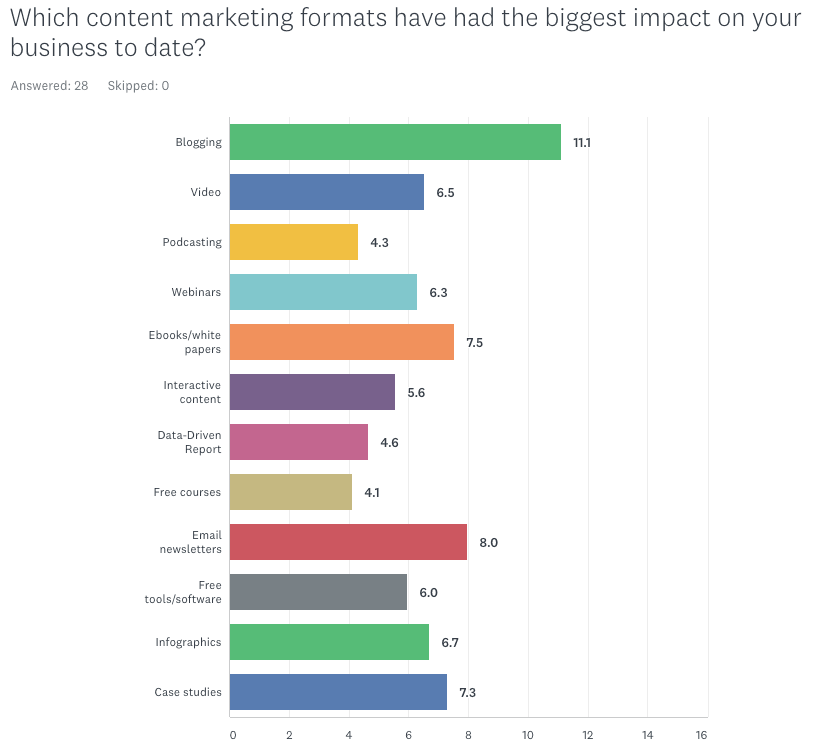
Content marketing has become one of the most powerful digital marketing strategies for various companies of all sizes and industries.
As long as it’s implemented properly, content marketing can become a business’s ticket to long-term success as this strategy can improve their visibility in search engines, provide more referral traffic, and boost their brand reputation. Content marketing can also help businesses create tighter customer relationships and save money on marketing costs.
P.S. Looking for ways to grow your online presence on Snapchat? Check out this post now.
However, when it comes to developing your content marketing strategy, it may seem like a daunting task to decide which types of content marketing to use to promote your business. When mentioning the word phrase “content marketing” most will think about the texts, some about the pictures, some will remember the videos they’ve recently watched on YouTube. Have you known that one can not only read and watch content but also listen to it and create it?
Contrary to popular belief, content marketing actually comes in many forms. This type of marketing strategy doesn’t only provide articles or blogs online—content marketing is more diverse than that.
Generally, content marketing has the following types:
1. Text content
If you want to promote your site, make it interesting with the help of different types of content marketing. Expert writers from EduQuickie advise the following types of text content you should choose to promote your business.
- Information article. It’s created to tell readers about certain facts, events, and phenomena. When creating information articles, it’s important to spend a lot of time researching. The information presented in the article should be facts and supported with studies and researches. These will give substance to your article.
- Article with tips: Material with recommendations and/or instructions to readers. These types of articles are usually written in a light tone to help readers relate to the content.
- Story: The story to convey important data or news to the reader – to induce him to think and certain actions. Generally, stories are written by known personalities or celebrities to easily convince readers to patronize products and services. The authors of these stories are also named to provide authenticity to the content.
- Article Review: Consideration of one or many similar problems, phenomena, or objects. It may be supported by illustrations and video.
- Digest: a collection of materials from other publications. It has a periodic nature ( it is released once a month). The digest introduces readers to a selection of news on a particular issue.
- A guide/manual. Its goal is to encourage the reader to test or gain skills and knowledge. After studying, the reader will have a whole set of theoretical skills to begin to act.
- Checklist: Actions in a strict or arbitrary order that must be performed to achieve a positive effect.
- Instructions: Instructions/rules that govern any detail. It is created to give readers the correct sequence of actions to get the desired result.
- Interview. A conversation, in which one person asks questions and the other answers them. A good interview helps not only to gain an expert opinion on issues of interest but also to increase the audience of readers.
- Posts in social networks (short messages or extensive reflections). Posts vary depending on the purpose.

Text content is one of the most common and used types of content marketing today, but choosing which to use for your business can be challenging. This is especially true if you’ve never implemented any content marketing in the past.
To help you choose among the different types of text content, consider hiring pros such as Caffeine Marketing. These agencies have years of experience in marketing, allowing you to create and implement strategies best that suit your business’s needs.
2. Graphic content
- Comics. The sequence of text and pictures, united by a common plot. Publishing comics online is a great way to inform readers about a certain topic and inject humor at the same time. The presence of pictures can break the monotony of texts, making the content more appealing and fun to read.
- Mind map. Recording material in the form of a structure, when a set of branches is made from the central element, where each can have its own branches. It serves to streamline information and facilitate its submission. Content marketers usually state that it is easier to create a structure for future articles with the help of mind maps.
- Infographics. The method of presenting complex data combining both text and graphics. It serves to facilitate the assimilation of bulk textual information. This is another fun way to present information to readers because instead of bombarding them with too many numbers, infographics are easy and fun to read.
- Gif-animation (“gifs”). These are moving images used to show interesting moments from videos, on social networks, and instant messengers – to create animated emoticons.
- Photos. They are used to illustrate text materials in blogs, social networks, online stores, etc. Photos may act as independent material and be combined into photo galleries.
- Pictures. This type of content marketing implies the use of an image created manually or by means of computer graphics. It serves the same purpose as photos. It is taken from popular photo hosting sites or is drawn specifically.
3. Audio content
- Audiobook. It is created for convenient listening in stationary conditions (at home, in the office). It is framed as a single file, but more often it splits into parts, where each is a separate chapter.
- Interview podcast/recording. It’s an audio content in the format of a file recorded.
- Song/music/jingle. It’s a short simple melody, often with words, which is easily remembered and used for advertising on radio or television.
- Webinar recording. This type of content is a soundtrack taken from a webinar. The content is designed for comfortable listening when there is no desire or ability to watch videos.
4. Video content
- Webinar. The meeting/presentation in the online mode, where the presenter tells something, the audience comments on the course of the broadcast, and in the end, he/she answers the questions. A great way to get your audience closer and get customers.
- Online streaming. Any live video content delivered. It is interesting because it shows the state of affairs in the “here and now” format and can be recorded for further viewing.
- Video Course / Lesson / Practicum. It may have different forms – live broadcast, video on YouTube, video file on a computer or video media. This is what a YouTube post looks like.
- Video for business. Scripted videos with the advertising of goods or services of the client.
- Infographics. Same as infographics, but executed in video format, where its elements are shown in motion.
- Viral video content. Short and funny, one you want to share. The format is popular for social networks. Important – a non-trivial idea that causes shock, curiosity, interest, and desire to watch again and again.
The difficulties of creating content will disappear only from a glance at its great diversity. Carefully study all the types of content marketing, and choose the most appropriate type of content for your business activity. Start creating the most useful content now!


